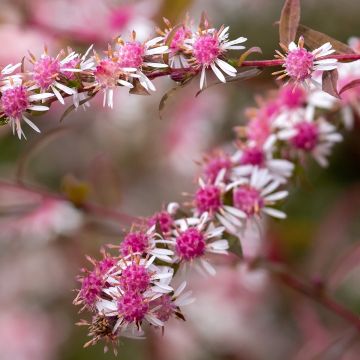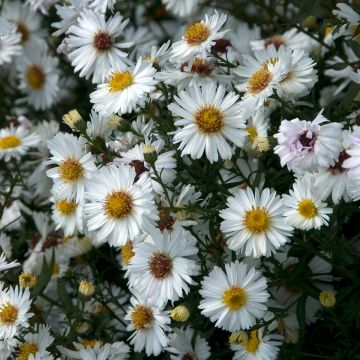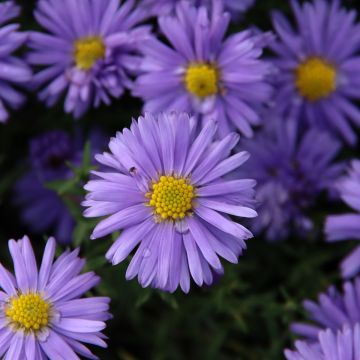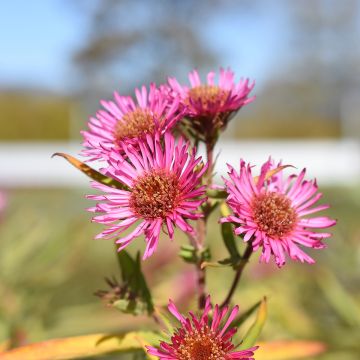

Eurybia schreberi - Schreber's aster
Eurybia schreberi - Schreber's aster
Aster schreberi
Schreber's aster, Nettle-leaved Michaelmas daisy
Why not try an alternative variety in stock?
View all →This plant carries a 12 months recovery warranty
More information
We guarantee the quality of our plants for a full growing cycle, and will replace at our expense any plant that fails to recover under normal climatic and planting conditions.
From €5.90 for pickup delivery and €6.90 for home delivery
Express home delivery from €8.90.
Delivery to Corse prohibited: UE law prohibits the import of this plant from mainland France to Corse as part of the fight against Xylella fastidiosa. Please accept our sincere apologies.
More information
Does this plant fit my garden?
Set up your Plantfit profile →
Description
Aster schreberi, also known by its botanical name Eurybia schreberi, is a North American wild species visually close to Aster divaricatus. It blooms in the shade and forms a wild-looking, fairly loose clump with large basal leaves with serrated edges, covered in late summer with numerous clusters of small, white, very bright starry daisy flowers with dark yellow centres. It prefers rich and fresh soils but can tolerate drier soil. Use it to add a natural and elegant touch and bring light to shaded areas and understoreys.
Aster schreberi or Eurybia schreberi belongs to the aster family. It is native to the eastern United States and Canada, where it is only present in Ontario. In the United States, it is found in all states east of Wisconsin, Iowa, Illinois, Kentucky, and Tennessee, with the exception of North Carolina and its south. It is classified as endangered in Indiana and Iowa, of concern in Tennessee, and possibly extinct in Maine. It has also been introduced to Europe, notably in Scotland. It is more common at altitudes below 1200 metres in mixed moist to medium-moist hardwood forests, most often with maples, elms, or oaks, as well as in thickets and shaded roadside edges. This perennial grows from a non-invasive clump-forming crown with short rhizomes. Its above-ground vegetation is deciduous, emerging from the ground in spring, quite late, around April-May, and drying up in autumn. This fast-growing plant forms a flexible, spreading, open clump, reaching approximately 70 cm, with a minimum width of 50 cm in rich, deep, and moist soils. Flowering generally occurs from August to September. The inflorescence is a small head with peripheral, ligulate white flowers. The central flowers (the heart) are yellow. Together, they form light clusters, composed of countless tiny stars with very fine 'branches'. This aster develops strong, well-branched, smooth, dark stems. The plant self-seeds spontaneously in the garden, sometimes abundantly if conditions suit it.
Undemanding Schreber's Aster pairs very well with other robust shade-loving perennials such as Ligularia dentata, or trachystemon orientale, or even with another woodland-loving aster, Aster cordifolius with a cultivar like 'Ideal' with lavender-blue flowers. With its knotty branches and spreading habit, it forms an excellent ground cover. Planted in groups of several plants, it looks stunning in front of large tree or shrub borders. This plant is also an excellent cut flower.
Report an error about the product description
Flowering
Foliage
Plant habit
Botanical data
Aster
schreberi
Asteraceae
Schreber's aster, Nettle-leaved Michaelmas daisy
Eurybia schreberi
North America
Other Asters
Planting and care
Plant Aster schreberi in spring or autumn, in garden soil that remains moist, even if it's chalky. Choose a semi-shaded or shaded location. It will be more beautiful in rich and deep soil, but also tolerates drier soil. Remove faded flowers and cut back the clump at the end of winter. Divide every 3 or 4 years to regenerate the crown and keep them safe from powdery mildew.
Planting period
Intended location
Care
This item has not been reviewed yet - be the first to leave a review about it.
Haven't found what you were looking for?
Hardiness is the lowest winter temperature a plant can endure without suffering serious damage or even dying. However, hardiness is affected by location (a sheltered area, such as a patio), protection (winter cover) and soil type (hardiness is improved by well-drained soil).

Photo Sharing Terms & Conditions
In order to encourage gardeners to interact and share their experiences, Promesse de fleurs offers various media enabling content to be uploaded onto its Site - in particular via the ‘Photo sharing’ module.
The User agrees to refrain from:
- Posting any content that is illegal, prejudicial, insulting, racist, inciteful to hatred, revisionist, contrary to public decency, that infringes on privacy or on the privacy rights of third parties, in particular the publicity rights of persons and goods, intellectual property rights, or the right to privacy.
- Submitting content on behalf of a third party;
- Impersonate the identity of a third party and/or publish any personal information about a third party;
In general, the User undertakes to refrain from any unethical behaviour.
All Content (in particular text, comments, files, images, photos, videos, creative works, etc.), which may be subject to property or intellectual property rights, image or other private rights, shall remain the property of the User, subject to the limited rights granted by the terms of the licence granted by Promesse de fleurs as stated below. Users are at liberty to publish or not to publish such Content on the Site, notably via the ‘Photo Sharing’ facility, and accept that this Content shall be made public and freely accessible, notably on the Internet.
Users further acknowledge, undertake to have ,and guarantee that they hold all necessary rights and permissions to publish such material on the Site, in particular with regard to the legislation in force pertaining to any privacy, property, intellectual property, image, or contractual rights, or rights of any other nature. By publishing such Content on the Site, Users acknowledge accepting full liability as publishers of the Content within the meaning of the law, and grant Promesse de fleurs, free of charge, an inclusive, worldwide licence for the said Content for the entire duration of its publication, including all reproduction, representation, up/downloading, displaying, performing, transmission, and storage rights.
Users also grant permission for their name to be linked to the Content and accept that this link may not always be made available.
By engaging in posting material, Users consent to their Content becoming automatically accessible on the Internet, in particular on other sites and/or blogs and/or web pages of the Promesse de fleurs site, including in particular social pages and the Promesse de fleurs catalogue.
Users may secure the removal of entrusted content free of charge by issuing a simple request via our contact form.
The flowering period indicated on our website applies to countries and regions located in USDA zone 8 (France, the United Kingdom, Ireland, the Netherlands, etc.)
It will vary according to where you live:
- In zones 9 to 10 (Italy, Spain, Greece, etc.), flowering will occur about 2 to 4 weeks earlier.
- In zones 6 to 7 (Germany, Poland, Slovenia, and lower mountainous regions), flowering will be delayed by 2 to 3 weeks.
- In zone 5 (Central Europe, Scandinavia), blooming will be delayed by 3 to 5 weeks.
In temperate climates, pruning of spring-flowering shrubs (forsythia, spireas, etc.) should be done just after flowering.
Pruning of summer-flowering shrubs (Indian Lilac, Perovskia, etc.) can be done in winter or spring.
In cold regions as well as with frost-sensitive plants, avoid pruning too early when severe frosts may still occur.
The planting period indicated on our website applies to countries and regions located in USDA zone 8 (France, United Kingdom, Ireland, Netherlands).
It will vary according to where you live:
- In Mediterranean zones (Marseille, Madrid, Milan, etc.), autumn and winter are the best planting periods.
- In continental zones (Strasbourg, Munich, Vienna, etc.), delay planting by 2 to 3 weeks in spring and bring it forward by 2 to 4 weeks in autumn.
- In mountainous regions (the Alps, Pyrenees, Carpathians, etc.), it is best to plant in late spring (May-June) or late summer (August-September).
The harvesting period indicated on our website applies to countries and regions in USDA zone 8 (France, England, Ireland, the Netherlands).
In colder areas (Scandinavia, Poland, Austria...) fruit and vegetable harvests are likely to be delayed by 3-4 weeks.
In warmer areas (Italy, Spain, Greece, etc.), harvesting will probably take place earlier, depending on weather conditions.
The sowing periods indicated on our website apply to countries and regions within USDA Zone 8 (France, UK, Ireland, Netherlands).
In colder areas (Scandinavia, Poland, Austria...), delay any outdoor sowing by 3-4 weeks, or sow under glass.
In warmer climes (Italy, Spain, Greece, etc.), bring outdoor sowing forward by a few weeks.



























































